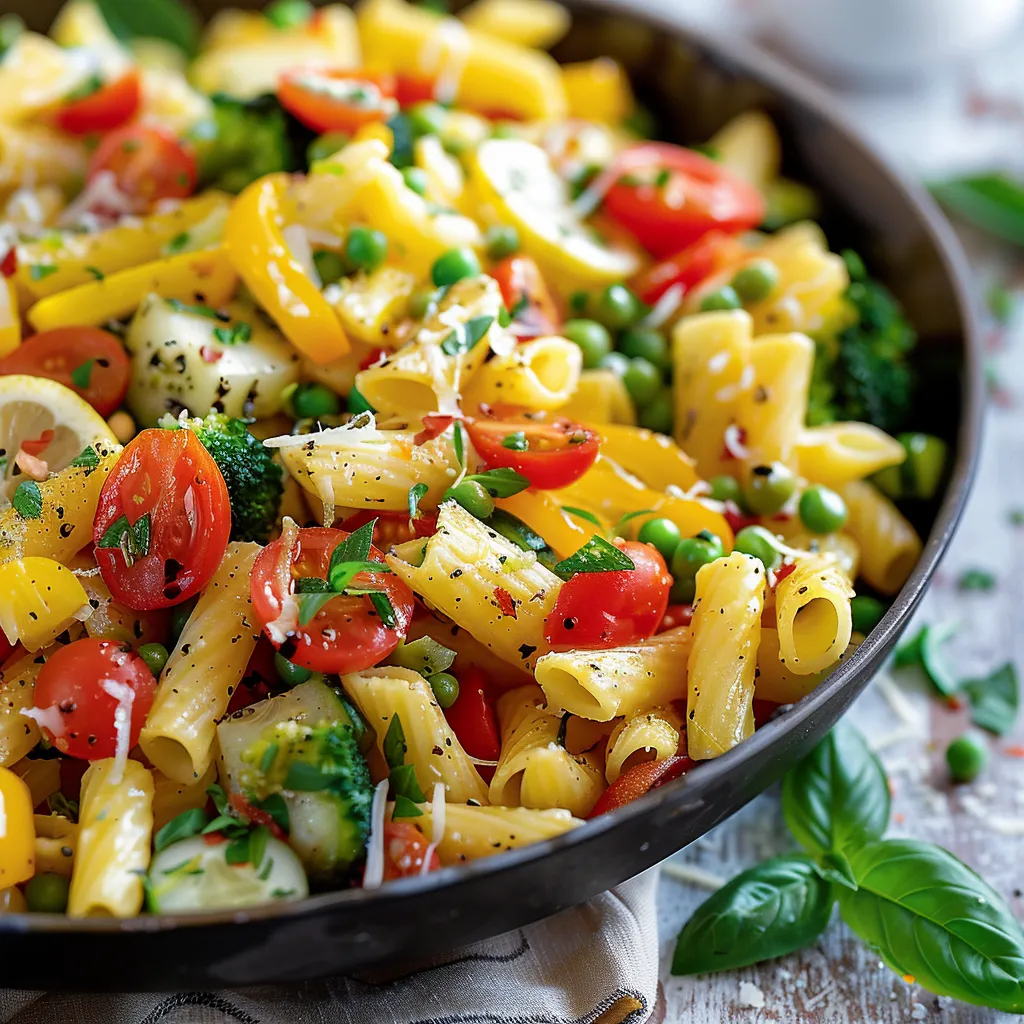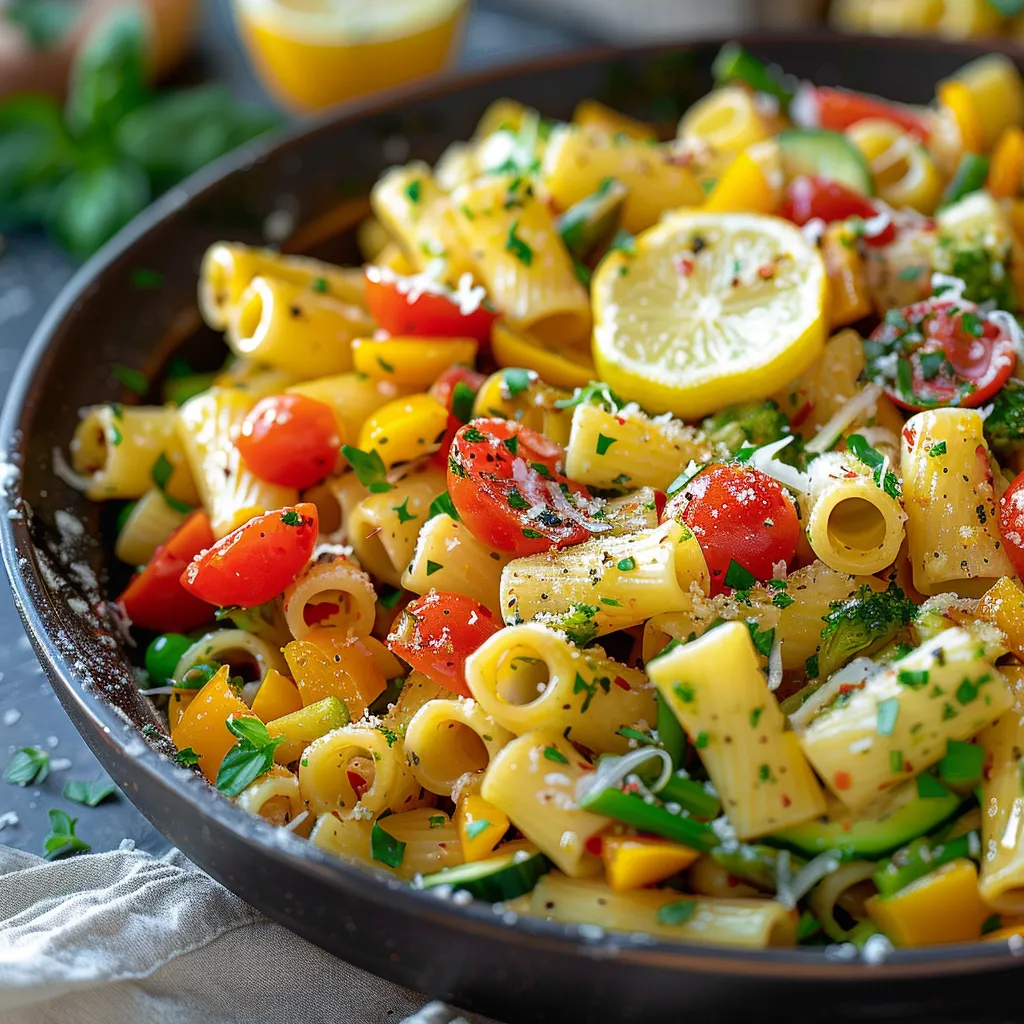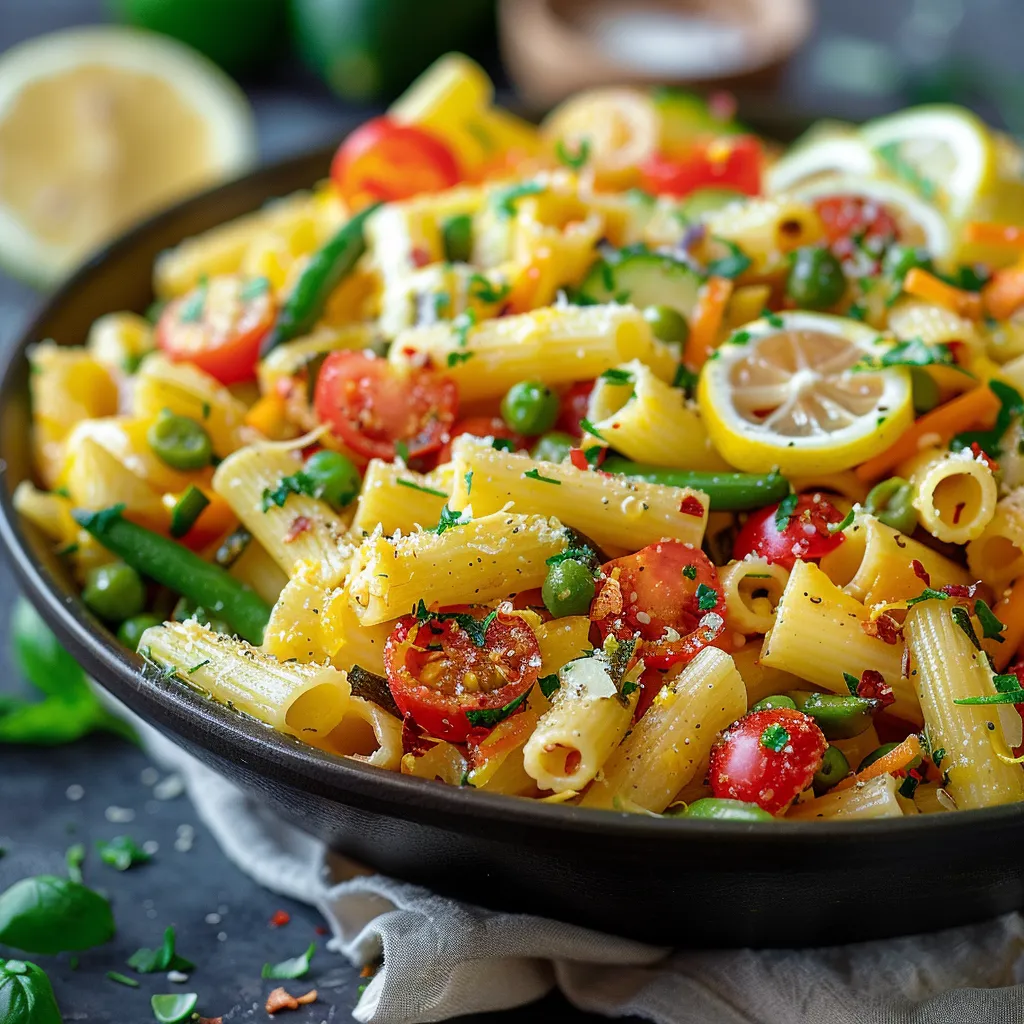 Pin it
Pin it
This colorful pasta primavera with lemon garlic butter has been my family's go-to meal for busy weeknights when we need a dose of vegetables without sacrificing flavor. The vibrant mix of seasonal vegetables tossed with pasta in a light, zesty sauce creates a meal that feels both indulgent and wholesome.
I first created this recipe during spring when our local farmers market was bursting with fresh produce. My children, who typically avoided vegetables, surprised me by asking for seconds and the dish quickly became our Sunday tradition when we want something light yet satisfying.
Ingredients
- Pasta: Choose penne or your favorite shape that catches the sauce in its ridges. Gluten free options work perfectly too
- Fresh seasonal vegetables: Zucchini, yellow squash, bell peppers, red onion and asparagus create a rainbow of nutrition and flavor on your plate
- Olive oil: Helps vegetables roast to caramelized perfection while preventing sticking
- Italian seasoning: This herb blend saves time while providing complex flavor notes throughout the dish
- Butter: Creates the silky base for our sauce. Use high quality for best flavor or substitute vegan butter successfully
- Fresh lemon: Both zest and juice brighten the entire dish and balance the richness of the butter
- Garlic: Adds depth and aromatic quality that makes this dish crave worthy
- Fresh basil: Provides a pop of color and herbaceous freshness that dried herbs simply cannot match
- Parmesan cheese: The salty umami finish that brings everything together. Use freshly grated for best melting quality
- Cherry tomatoes: Added fresh at the end for a burst of sweet acidity that contrasts beautifully with the roasted vegetables
Step-by-Step Instructions
- Cook the Pasta:
- Bring a large pot of heavily salted water to a rolling boil before adding pasta. Cook until just al dente according to package directions, typically 8 to 10 minutes. Before draining, carefully reserve half a cup of starchy cooking water this secret ingredient will help our sauce cling to every piece of pasta. Drain pasta and set aside while preparing other components.
- Prepare Vegetables:
- Slice all vegetables uniformly to ensure even cooking. The two inch pieces work perfectly to match the size of pasta, creating balanced bites where no ingredient overwhelms another. Making sure your asparagus ends are properly trimmed prevents any woody textures in the finished dish.
- Roast the Vegetables:
- Tossing vegetables with olive oil and seasonings before roasting ensures even flavor distribution. Spread them in a single layer on your baking sheet this allows proper air circulation for caramelization instead of steaming. The 425 degree temperature is crucial for developing those beautiful browned edges that intensify the vegetable flavors.
- Create the Sauce:
- Using the same pot where you cooked pasta captures residual starch that helps emulsify the sauce. Melt butter slowly over medium low heat to prevent burning. Add garlic only after butter has melted to prevent scorching. The delicate balance of lemon zest, juice, and garlic creates a foundation that elevates simple butter to something extraordinary.
- Combine Components:
- Adding pasta water gradually allows you to control the consistency of your sauce. Start with just a quarter cup and add more only if needed. Toss continuously as you combine ingredients to ensure every piece of pasta gets evenly coated. Adding tomatoes last preserves their fresh texture and bright flavor.
- Finish and Serve:
- The final addition of Parmesan and fresh herbs should happen just before serving for maximum impact. Taste and adjust salt levels at this stage since Parmesan adds saltiness that varies by brand. Serve immediately while the contrast between warm pasta and fresh elements is at its peak.
 Pin it
Pin it
The first time I served this pasta primavera, my husband skeptically asked where the meat was. After one bite, he declared it might be the best pasta dish I had ever made. The roasted vegetables develop such depth of flavor that even dedicated carnivores find it satisfying without additions.
Vegetable Variations
This pasta primavera recipe truly shines with seasonal adaptations. In summer, substitute the asparagus with fresh corn kernels cut straight from the cob and add extra cherry tomatoes. For autumn, try cubed butternut squash and brussels sprouts which caramelize beautifully in the oven. Winter versions work wonderfully with hearty root vegetables like parsnips and carrots alongside kale that crisps slightly when roasted. The technique remains the same regardless of which vegetables you choose.
Make Ahead Strategy
While this dish is best served fresh, busy weeknights sometimes require advance preparation. Roast vegetables up to two days ahead and store in an airtight container in the refrigerator. Cook pasta just before serving and refresh vegetables by warming them in the butter sauce for about two minutes before adding the pasta. This preserves the vibrant colors and prevents the mushy texture that can happen when vegetables are reheated multiple times.
Protein Additions
Though perfect as a vegetarian main dish, protein lovers can customize their pasta primavera easily. Add grilled chicken breast cut into strips for a classic addition that absorbs the lemon garlic flavors beautifully. Sautéed shrimp works exceptionally well with the lemon notes in the sauce. For vegetarian protein, white beans or chickpeas can be roasted alongside the vegetables, developing a slightly crisp exterior while remaining creamy inside.
 Pin it
Pin it
This vegetable-packed pasta primavera is sure to become a staple in your dinner rotation—easy, adaptable and bursting with fresh flavor!
Frequently Asked Questions
- → Can I use different vegetables in this pasta primavera?
Absolutely! Pasta primavera is extremely versatile. While this version uses zucchini, yellow squash, bell peppers, red onion, and asparagus, you can substitute with whatever vegetables are in season or your favorites. Broccoli, cauliflower, carrots, peas, or mushrooms all work beautifully.
- → Is this dish suitable for vegetarians?
Yes, this pasta primavera is vegetarian as written. It contains Parmesan cheese and butter, so it's not vegan, but you can easily substitute with vegan butter and either omit the cheese or use a plant-based Parmesan alternative.
- → How can I make this pasta primavera gluten-free?
Simply use your favorite gluten-free pasta as mentioned in the ingredients list. The rest of the ingredients are naturally gluten-free, making this an easy dish to adapt for those with gluten sensitivities.
- → What's the best way to reheat leftover pasta primavera?
Reheat leftovers on the stovetop over medium-low heat or in the microwave. Add a splash of water before reheating to help restore moisture and prevent the pasta from drying out. Stir occasionally during reheating for even warming.
- → Can I add protein to this pasta dish?
Definitely! This pasta primavera works wonderfully with added protein. Try adding grilled chicken, sautéed shrimp, or even white beans for a protein boost. Simply cook your protein separately and add it when combining the pasta with the vegetables and sauce.
- → Why reserve pasta water for the sauce?
The starchy pasta water helps create a silky sauce that clings to the pasta and vegetables. It also helps emulsify the butter and lemon juice, creating a more cohesive sauce. If your sauce seems too thick, adding a bit more pasta water will help thin it to the perfect consistency.
